Like a master artist selecting the perfect palette, choosing the right plants for your bathroom requires careful consideration of light, humidity, and space. You’ll discover that certain botanical varieties don’t just survive in bathroom conditions; they thrive in them. From air-purifying champions to low-maintenance beauties, these eight plants can transform your daily routine into a spa-like experience. Let’s explore how each of these natural elements can elevate your bathroom’s aesthetic while working harmoniously with its unique environment.
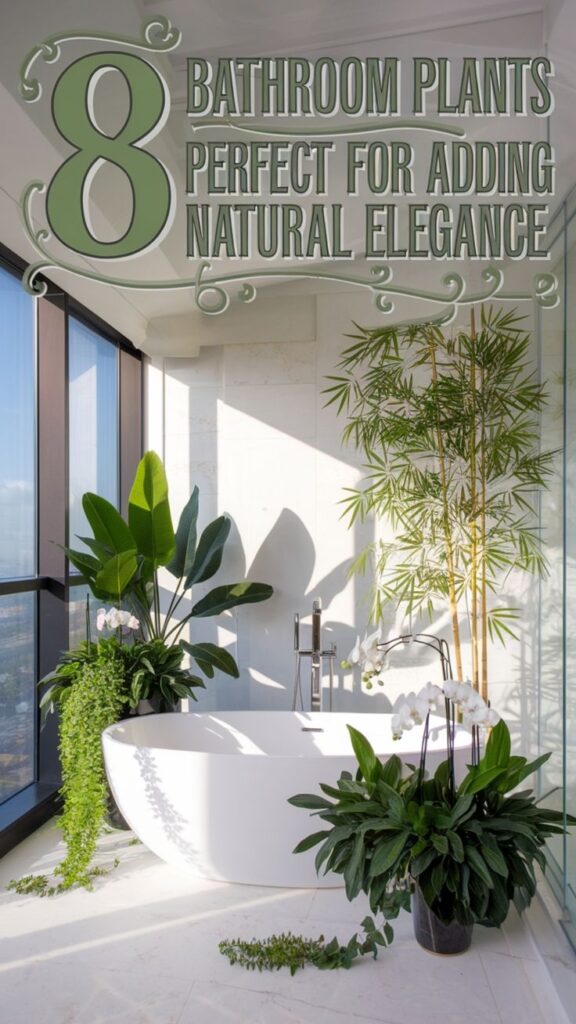
Contents
- 1 Lush Boston Ferns: The Classic Humidity Lover
- 2 Peace Lily: Elegant Air-Purifying Beauty
- 3 Snake Plant: Low-Light Bathroom Warrior
- 4 Bamboo: The Zen Shower Companion
- 5 Orchids: Tropical Luxury for Your Vanity
- 6 Pothos: The Adaptable Trailing Wonder
- 7 Air Plants: No-Soil Solutions for Small Spaces
- 8 Spider Plant: The Moisture-Loving Cascader
Lush Boston Ferns: The Classic Humidity Lover
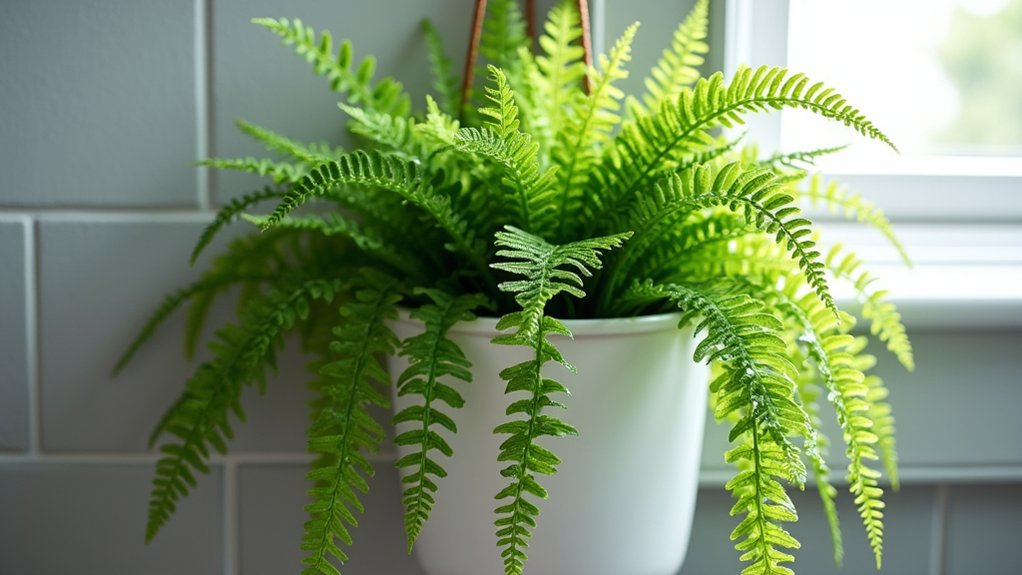
Boston Ferns (Nephrolepis exaltata) are iconic bathroom plants featuring graceful, arching fronds with delicate, feather-like leaflets that cascade downward.
These elegant plants can grow up to 3 feet wide and create a dramatic, tropical atmosphere with their lush, emerald-green foliage that adds instant sophistication to any bathroom space.
- Light: Bright, indirect light; avoid direct sunlight
- Water: Keep soil consistently moist but not waterlogged
- Humidity: Minimum 50%; higher levels preferred
- Temperature: 60-75°F (16-24°C)
- Soil: Well-draining, rich potting mix with high organic content
- Fertilizer: Monthly feeding during growing season with balanced liquid fertilizer
- Container: Use pots with adequate drainage holes
Regular grooming is essential for maintaining a Boston Fern’s appealing appearance.
Remove any yellow or brown fronds at the base using clean, sharp scissors, and periodically rotate the plant to ensure even growth.
Mist the plant between waterings if bathroom humidity drops, and periodically clean the fronds with a soft brush to remove dust.
During winter, reduce watering slightly but never allow the soil to dry out completely, as this can cause irreversible damage to the plant’s delicate root system.
Peace Lily: Elegant Air-Purifying Beauty
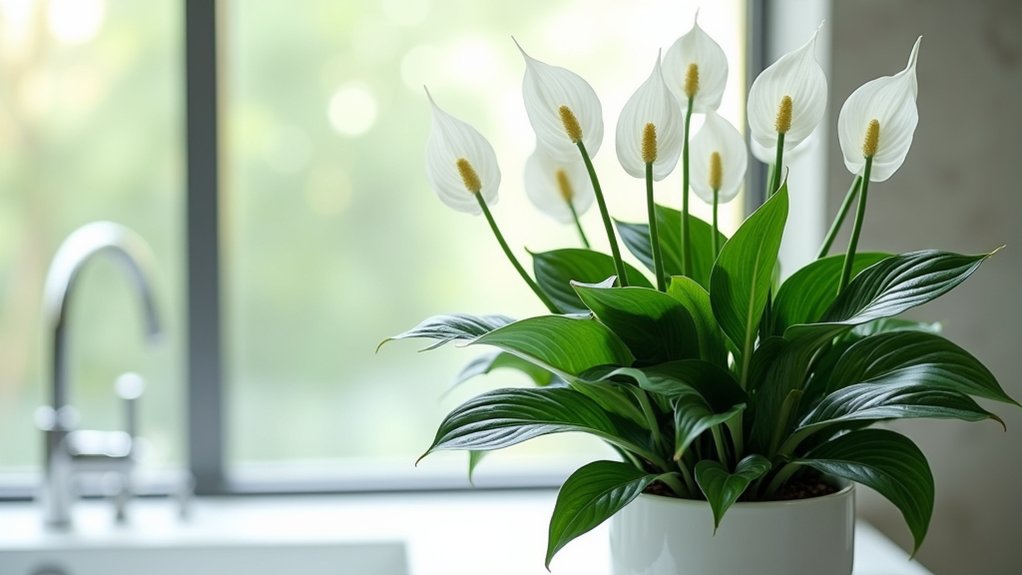
The Peace Lily (Spathiphyllum) is a striking tropical plant characterized by its glossy, dark green leaves and distinctive white flowers that resemble calla lilies. This elegant plant is renowned for its air-purifying abilities, effectively removing common household toxins like formaldehyde and benzene.
The white blooms, which are actually modified leaves called spathes, emerge periodically throughout the year, creating a stunning contrast against the deep foliage.
- Light: Thrives in low to moderate indirect light; avoid direct sunlight
- Water: Keep soil consistently moist but not waterlogged; water when top inch of soil feels dry
- Humidity: Prefers high humidity levels above 50%
- Temperature: Maintains best growth between 65-80°F (18-27°C)
- Soil: Well-draining potting mix rich in organic matter
- Fertilizer: Feed with balanced liquid fertilizer every 6-8 weeks during growing season
Regular grooming is essential for maintaining a healthy Peace Lily. Remove yellowed or damaged leaves at the base using clean, sharp scissors.
Dust the leaves monthly with a damp cloth to ensure optimal photosynthesis and maintain the plant’s air-purifying efficiency. Watch for leaf tips turning brown, which often indicates mineral buildup from tap water – using filtered water can prevent this issue.
If flowers begin to fade, cut the stalks back to the base to encourage new blooms.
Snake Plant: Low-Light Bathroom Warrior
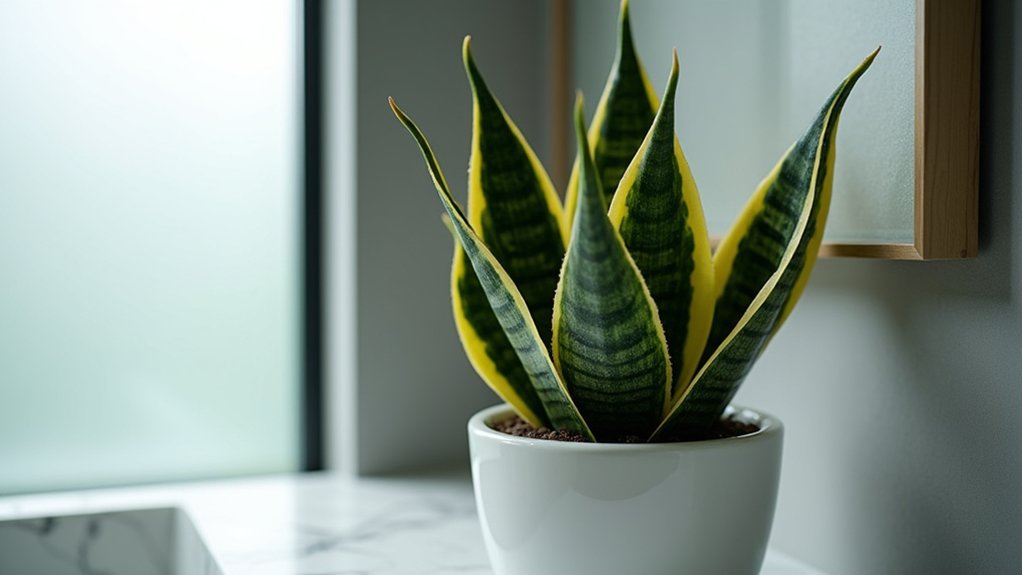
The Snake Plant (Sansevieria trifasciata) is a striking bathroom plant with tall, rigid, sword-like leaves that grow upright in dense clusters. Its distinctive variegated pattern features dark green bands with lighter green or yellow edges, giving it an architectural presence. This hardy succulent can grow anywhere from 6 inches to several feet tall, depending on the variety, and its air-purifying capabilities make it particularly well-suited for bathroom environments.
- Light: Tolerates low light to bright indirect light; avoid direct sunlight
- Water: Allow soil to dry completely between waterings; water every 2-6 weeks
- Soil: Well-draining potting mix; preferably succulent or cactus soil
- Humidity: Adapts to any humidity level
- Temperature: Thrives in 70-90°F (21-32°C)
- Container: Pot with drainage holes to prevent root rot
To maintain a healthy Snake Plant, regularly dust the leaves with a damp cloth to keep their pores clear and maintain their striking appearance. Remove any yellowed or damaged leaves at the base, and check occasionally for signs of root rot, which can develop if the plant is overwatered.
While Snake Plants are slow-growing, they may need repotting every 2-3 years when becoming root-bound, best done during the growing season in spring or summer.
Bamboo: The Zen Shower Companion
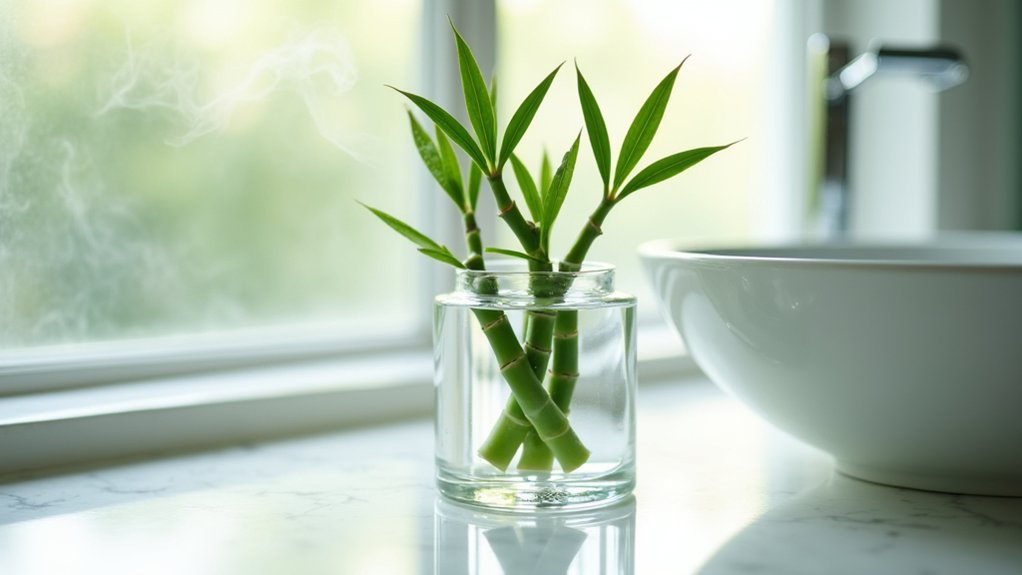
Lucky bamboo brings an elegant, minimalist aesthetic to bathroom spaces with its sleek, jointed stems and emerald-green leaves arranged in a spiral pattern.
Despite its name, it’s actually a member of the Dracaena family rather than true bamboo. This versatile plant can be grown in water or soil, and its vertical growth pattern makes it ideal for tight bathroom spaces, while its cultural significance as a symbol of good fortune adds to its appeal.
- Light: Thrives in bright, indirect light; can tolerate lower light conditions
- Water: When grown in water, change water weekly; in soil, keep consistently moist but not waterlogged
- Temperature: Prefers warm environments between 65-90°F
- Humidity: Enjoys high humidity levels naturally found in bathrooms
- Soil: If planted in soil, use well-draining potting mix rich in organic matter
- Container: Clear glass containers for water-grown specimens; well-draining pots for soil-grown plants
Regular grooming is essential for maintaining lucky bamboo‘s attractive appearance and health.
Remove any yellowed or dead leaves promptly, and trim the tops of stems that grow too tall to maintain desired height and encourage bushier growth.
If growing in water, add a drop of liquid fertilizer every other month, and always use filtered or distilled water to prevent fluoride damage.
Watch for signs of algae growth in water-based systems and clean containers as needed.
Orchids: Tropical Luxury for Your Vanity

Orchids bring an elegant, exotic touch to bathroom spaces with their delicate, long-lasting blooms and graceful stems. These tropical beauties come in countless varieties, featuring flowers in vibrant colors from pure white to deep purple, often displaying intricate patterns and unique shapes.
Their striking appearance, combined with their natural affinity for humidity, makes them ideal candidates for bathroom décor, particularly when placed on vanities where they can serve as living artwork.
- Light: Bright, indirect light; avoid direct sunlight which can burn leaves
- Humidity: 50-70% relative humidity
- Temperature: 65-80°F (18-27°C)
- Water: Weekly watering, allowing soil to dry slightly between waterings
- Potting Medium: Specialized orchid mix with excellent drainage
- Container: Clear plastic or clay pots with drainage holes
- Fertilizer: Balanced orchid fertilizer at quarter strength every 2-3 weeks during growing season
Maintaining healthy orchids requires attention to a few key practices beyond basic growing conditions. Remove spent blooms promptly to encourage new growth, and repot every 1-2 years when the growing medium begins to break down.
Clean leaves monthly with a damp cloth to remove dust and prevent pest problems. During winter months, reduce fertilizing frequency and watch for signs of cold damage.
Rotate the plant periodically to ensure even growth, and inspect roots regularly through clear containers to monitor overall plant health.
Pothos: The Adaptable Trailing Wonder

Pothos (Epipremnum aureum) is a versatile trailing plant known for its heart-shaped leaves that come in various patterns, including golden-yellow variegation, marble white, or solid green.
This hardy vine can grow several feet long, making it perfect for hanging baskets, climbing poles, or cascading from high shelves. Its aerial roots allow it to climb naturally, while its thick, waxy leaves help it retain moisture and survive in various indoor conditions.
Growing Conditions:
- Light: Tolerates low to bright indirect light; avoid direct sunlight
- Water: Allow top 1-2 inches of soil to dry between waterings
- Soil: Well-draining potting mix
- Temperature: 60-80°F (15-27°C)
- Humidity: Adaptable to average home humidity
- Fertilizer: Monthly feeding during growing season with balanced liquid fertilizer
Regular pruning helps maintain the plant’s desired shape and promotes bushier growth.
Remove yellowing or damaged leaves promptly, and wipe the leaves occasionally with a damp cloth to remove dust and maintain their photosynthetic efficiency.
When vines become leggy or bare, trim them back to encourage new growth from the base.
Consider propagating trimmed sections in water to create new plants or fill out the existing pot for a fuller appearance.
Air Plants: No-Soil Solutions for Small Spaces
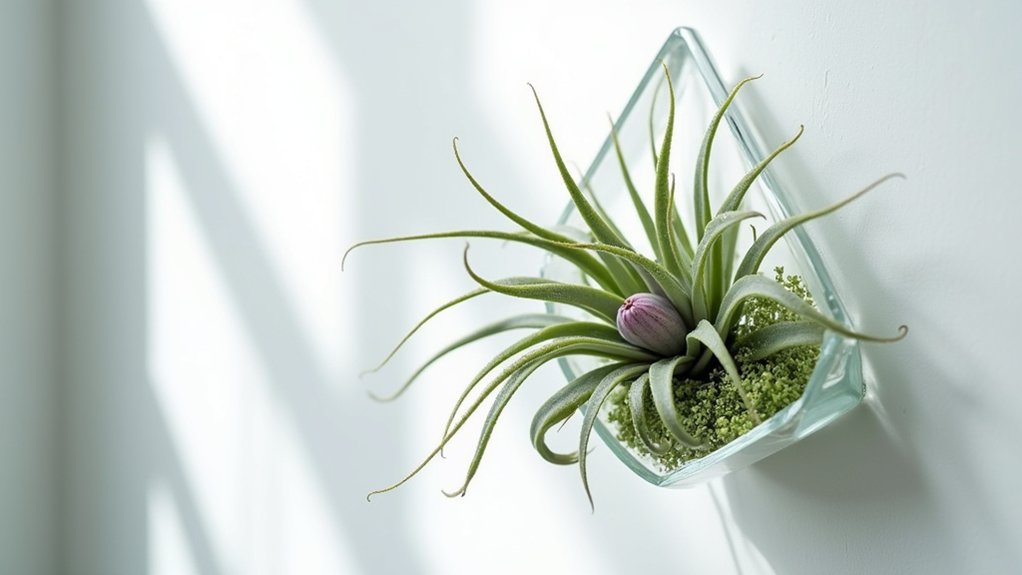
Air plants (Tillandsia) are unique botanical wonders that grow without the need for soil, making them perfect for bathroom environments. These peculiar plants feature silvery-green leaves arranged in rosette patterns, with some varieties displaying vibrant colors and producing striking blooms. Their ability to absorb moisture and nutrients through specialized scales on their leaves allows them to thrive while mounted on surfaces or suspended in decorative holders.
- Light: Bright, indirect light; avoid direct sunlight which can burn leaves
- Water: 2-3 thorough mists weekly in humid bathrooms; weekly 30-minute soaking in low-humidity environments
- Temperature: Prefer 50-90°F (10-32°C)
- Humidity: Thrive in humidity levels of 50-70%
- Mounting: Can be displayed on cork, wood, shells, or in glass containers
- Ventilation: Need good air circulation to prevent rot
To maintain healthy air plants, rotate them periodically to ensure even growth and prevent one-sided development. After watering, shake off excess moisture and place them upside down until completely dry to prevent water from pooling in the crown, which can lead to rot.
Remove any dead or browning leaves by gently pulling them off, and fertilize monthly during growing season with a bromeliad-specific fertilizer at quarter strength to promote growth and blooming.
Spider Plant: The Moisture-Loving Cascader
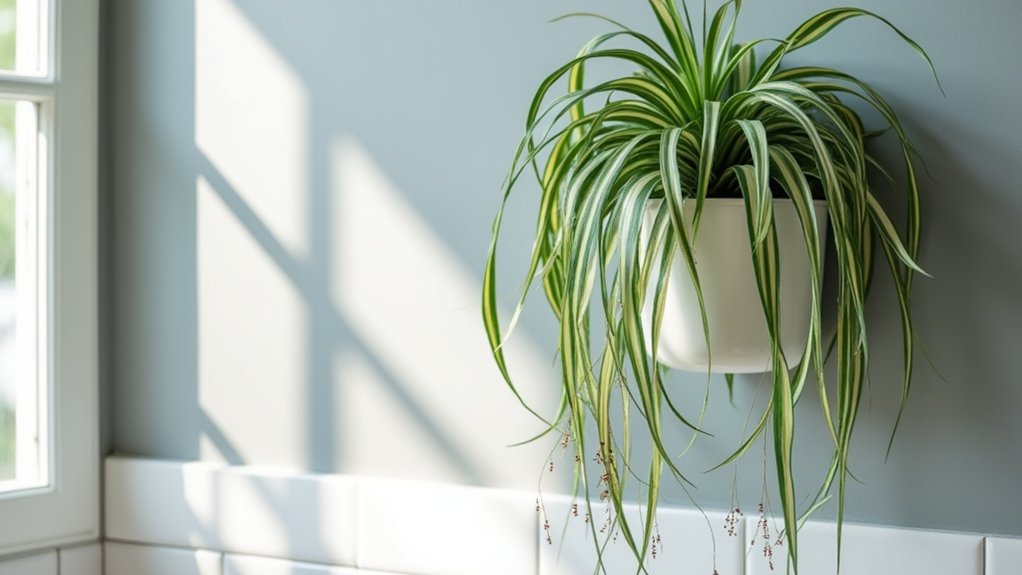
Spider Plants (Chlorophytum comosum) are elegant cascading plants known for their arching leaves that grow from a central rosette. Their slender, ribbon-like foliage features distinctive variegated stripes in green and white, creating a striking visual display.
These adaptable plants earn their common name from their spiderette offspring, which dangle from long stems like spiders on a web, making them perfect for hanging baskets or elevated displays in bathrooms.
- Light: Bright indirect light; tolerates lower light conditions but may lose variegation
- Water: Keep soil consistently moist but not waterlogged; water when top inch of soil feels dry
- Humidity: Thrives in high humidity environments of 60% or higher
- Temperature: Comfortable in normal room temperatures between 60-75°F (15-24°C)
- Soil: Well-draining potting mix with good aeration
- Container: Pot with drainage holes to prevent root rot
- Fertilizer: Monthly feeding during growing season with balanced liquid fertilizer
Regular grooming keeps Spider Plants looking their best and promotes healthy growth. Remove any yellowed or brown leaves at the base, and trim damaged leaf tips with clean scissors.
The plant’s spiderettes can either be left to create a dramatic trailing effect or removed to maintain a more compact appearance. When spiderettes become heavy, they may strain the parent plant, so periodic removal can help direct energy back to the main plant.
While Spider Plants rarely encounter serious problems, watch for brown leaf tips, which often indicate either over-fertilization or mineral buildup from tap water.
